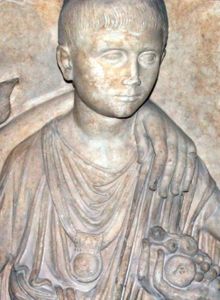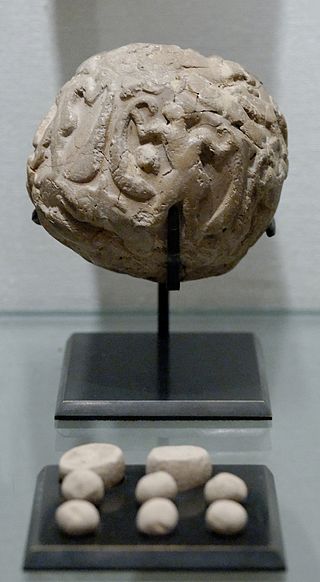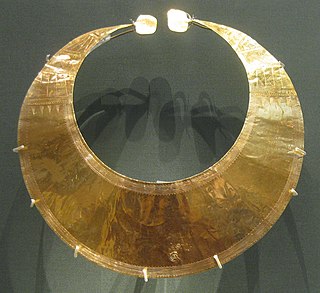

A bulla, an amulet worn like a locket, was given to male children in Ancient Rome nine days after birth. Rather similar objects are rare finds from Late Bronze Age Ireland.


A bulla, an amulet worn like a locket, was given to male children in Ancient Rome nine days after birth. Rather similar objects are rare finds from Late Bronze Age Ireland.

Roman bullae were enigmatic objects of lead, sometimes covered in gold foil, if the family could afford it. A bulla was worn around the neck as a locket to protect against evil spirits and forces. Bullae were made of differing substances depending upon the wealth of the family.
Before the age of manhood, Roman boys wore a bulla, a neckchain and round pouch containing protective amulets (usually phallic symbols), and the bulla of an upper-class boy would be made of gold. [1] Other materials included leather and cloth.
A freeborn Roman boy wore a bulla until he came of age as a Roman citizen. Before he put on his toga virilis ("toga of manhood") he placed his boyhood bulla in the care of his parental household deities (Lares). [2] Some modern sources interpret Macrobius's single reference to an amulet worn by a triumphal general during his procession as evidence that the childhood bulla was also a standard item of triumphal regalia. [3]
A Roman girl did not wear a bulla per se, [4] but another kind of amulet called a lunula , until the eve of her marriage, when it was removed along with her childhood toys and other things. She would then stop wearing child's clothes and start wearing women's Roman dress.
A small number of bullae have been found in Ireland; they are called "bullae" based on their resemblance to the Roman form. [lower-alpha 1] The Irish bullae so far found were made of base metal [lower-alpha 2] – sometimes clay – covered with a folded over piece of gold foil. The Irish bullae date to the Late Bronze Age, about 1150–750 BCE.
They were presumably worn suspended round the neck with a cord running through the hole below the flat top. The body of the bulla has roughly vertical sides before making a semi-circle or inverted pointed arch at the bottom. The gold is incised with geometrical decoration.
Whether they were purely for adornment or had an amuletic or other function is unclear. Despite the small weight of gold used they would have been available only for elite groups. [5] [6] [7] [8]

Jewellery consists of decorative items worn for personal adornment such as brooches, rings, necklaces, earrings, pendants, bracelets, and cufflinks. Jewellery may be attached to the body or the clothes. From a western perspective, the term is restricted to durable ornaments, excluding flowers for example. For many centuries metal such as gold often combined with gemstones, has been the normal material for jewellery, but other materials such as glass, shells and other plant materials may be used.

The toga, a distinctive garment of Ancient Rome, was a roughly semicircular cloth, between 12 and 20 feet in length, draped over the shoulders and around the body. It was usually woven from white wool, and was worn over a tunic. In Roman historical tradition, it is said to have been the favored dress of Romulus, Rome's founder; it was also thought to have originally been worn by both sexes, and by the citizen-military. As Roman women gradually adopted the stola, the toga was recognized as formal wear for male Roman citizens. Women found guilty of adultery and women engaged in prostitution might have provided the main exceptions to this rule.

A pendant is a loose-hanging piece of jewellery, generally attached by a small loop to a necklace, which may be known as a "pendant necklace". A pendant earring is an earring with a piece hanging down. Its name stems from the Latin word pendere and Old French word pendr, both of which translate to "to hang down". In modern French, pendant is the gerund form of pendre and also means "during". The extent to which the design of a pendant can be incorporated into an overall necklace makes it not always accurate to treat them as separate items.

A torc, also spelled torq or torque, is a large rigid or stiff neck ring in metal, made either as a single piece or from strands twisted together. The great majority are open at the front, although some have hook and ring closures and a few have mortice and tenon locking catches to close them. Many seem designed for near-permanent wear and would have been difficult to remove.

A necklace is an article of jewellery that is worn around the neck. Necklaces may have been one of the earliest types of adornment worn by humans. They often serve ceremonial, religious, magical, or funerary purposes and are also used as symbols of wealth and status, given that they are commonly made of precious metals and stones.

A brooch is a decorative jewellery item designed to be attached to garments, often to fasten them together. It is usually made of metal, often silver or gold or some other material. Brooches are frequently decorated with enamel or with gemstones and may be solely for ornament or serve a practical function as a clothes fastener. The earliest known brooches are from the Bronze Age. As fashions in brooches changed rather quickly, they are important chronological indicators. In archaeology, ancient European brooches are usually referred to by the Latin term fibula.

Lustratio was an ancient Greek and ancient Roman purification ritual. It included a procession and in some circumstances the sacrifice of a pig (sus), a ram (ovis), and a bull (taurus) (suovetaurilia). The name is the source of English "lustration".

A bulla is an inscribed clay, soft metal, bitumen, or wax token used in commercial and legal documentation as a form of authentication and for tamper-proofing whatever is attached to it.
Jewelry of the Etruscan civilization existed in several eras.

Clothing in ancient Rome generally comprised a short-sleeved or sleeveless, knee-length tunic for men and boys, and a longer, usually sleeved tunic for women and girls. On formal occasions, adult male citizens could wear a woolen toga, draped over their tunic, and married citizen women wore a woolen mantle, known as a palla, over a stola, a simple, long-sleeved, voluminous garment that modestly hung to cover the feet. Clothing, footwear and accoutrements identified gender, status, rank and social class. This was especially apparent in the distinctive, privileged official dress of magistrates, priesthoods and the military.

The preservation of fabric fibers and leathers allows for insights into the attire of ancient societies. The clothing used in the ancient world reflects the technologies that these peoples mastered. In many cultures, clothing indicated the social status of various members of society.

In ancient Roman religion and magic, the fascinus or fascinum was the embodiment of the divine phallus. The word can refer to phallus effigies and amulets, and to the spells used to invoke his divine protection. Pliny called it a medicus invidiae, a "doctor" or remedy for envy or the evil eye.

An amulet, also known as a good luck charm or phylactery, is an object believed to confer protection upon its possessor. The word "amulet" comes from the Latin word amuletum, which Pliny's Natural History describes as "an object that protects a person from trouble". Anything can function as an amulet; items commonly so used include statues, coins, drawings, plant parts, animal parts, and written words.

Clothing in ancient Greece refers to clothing starting from the Aegean bronze age to the Hellenistic period. Clothing in ancient Greece included a wide variety of styles but primarily consisted of the chiton, peplos, himation, and chlamys. Ancient Greek civilians typically wore two pieces of clothing draped about the body: an undergarment and a cloak. The people of ancient Greece had many factors that determined what they wore and when they wore it.

Gold working in the Bronze Age British Isles refers to the use of gold to produce ornaments and other prestige items in the British Isles during the Bronze Age, between c. 2500 and c. 800 BCE in Britain, and up to about 550 BCE in Ireland. In this period, communities in Britain and Ireland first learned how to work metal, leading to the widespread creation of not only gold but also copper and bronze items as well. Gold artefacts in particular were prestige items used to designate the high status of those individuals who wore, or were buried with them.

The Middle Ages was a period that spanned approximately 1000 years and is normally restricted to Europe and the Byzantine Empire. The material remains we have from that time, including jewelry, can vary greatly depending on the place and time of their creation, especially as Christianity discouraged the burial of jewellery as grave goods, except for royalty and important clerics, who were often buried in their best clothes and wearing jewels. The main material used for jewellery design in antiquity and leading into the Middle Ages was gold. Many different techniques were used to create working surfaces and add decoration to those surfaces to produce the jewellery, including soldering, plating and gilding, repoussé, chasing, inlay, enamelling, filigree and granulation, stamping, striking and casting. Major stylistic phases include barbarian, Byzantine, Carolingian and Ottonian, Viking, and the Late Middle Ages, when Western European styles became relatively similar.
A lunula was a crescent moon shaped pendant worn by girls in ancient Rome. Girls ideally wore them as an apotropaic amulet, the equivalent of the boy's bulla. In the popular belief the Romans wore amulets usually as a talisman, to protect themselves against evil forces, demons and sorcery, but especially against the evil eye. Lunulae were common throughout the entire Mediterranean region while their male counterpart, the bulla, was most popular in Italy. In Plautus' play, Epidicus asks the young girl Telestis: "Don't you remember my bringing you a gold lunula on your birthday, and a little gold ring for your finger?" An explicit definition is provided by Isidore of Seville: "Lunulae are female ornaments in the likeness of the moon, little hanging gold bullae." But in Plautus' play Rudens, Palaestra says her father gave her a golden bulla on the day of her birth.

Ancient Roman jewelry was characterized by an interest in colored gemstones and glass, in contrast with their Greek predecessors who focused primarily on the production of high-quality metalwork by practiced artisans. Extensive control of Mediterranean territories provided an abundance of natural resources to utilize in jewelry making. Participation in trade allowed access to both semi-precious and precious stones that traveled down the Persian Silk Road from the East.

The Shropshire bulla, also known as the Shropshire sun pendant, is a Late Bronze Age gold pendant found by a metal detectorist in 2018 in Shropshire, England. Made primarily of gold, it is the eighth bulla discovered to date in Great Britain and Ireland, and only the second in Britain. The pendant, decorated with intricately carved geometric designs, is now in the British Museum in London.

Crepundia are groups of amulets, often strung onto chains in Classical antiquity. They are similar to charm bracelets and are archaeologically associated with children.